#Abe history
Explore tagged Tumblr posts
Text
Dining, Shopping and Fun Experiences in Kenosha, WI!
My friend Annie Jansen and I headed to the beautiful harbor town of Kenosha, Wisconsin. We went for fun experiences in Kenosha! Hosted by Visit Kenosha Wisconsin, we hoped to see water, nature, history and art. We did all that and more! Thank you, Visit Kenosha, and Meridith Jumisko Public Relations Director, for allowing us to visit and share this marvelous experience. First things first! A…
#100th anniversary of Lincoln&039;s birth#Abe history#Abraham Lincoln statue#airbnb#American fare#Anna&039;s on the Lake#Annie Jansen#best breakfast in Kenosha#best burgers in Kenosah#best lunch in Kenosha#Boundless Adentures#breakfast stops#Bristol Wisconsin#Bristol Woods Park#brochures#Captain Bart Mengo#Captain Mike&039;s#Captain&039;s Quarters#Chris Meter#Civil War#Civil War Museum#coffee shop#Col. Jennifer Pritaker#Cordelia A.P. Harvey#courses#Cream City Brick#customer satisfaction#dining#Equinox Botanical Boutique#Erika Davis
0 notes
Text
a concerning amount of witchblr will be like "um actually new years was stolen by europeans from the ancient god scroobus mcdoobus" and then you actually try to research scroobus mcdoobus and it turns out he was invented in the 1940s by a conspiracy theorist who powdered every meal with ketamine and thinks that queer people are reincarnated fish
#brightts ramblings#BEFORE I GET ATTACKED: THIS IS NOT AN ANTI-WITCH OR ANTI-PAGAN POST#im just literally begging witchblr and paganblr(?) to study history from proper sources#so you don't accidentally end up repeating misinfo or even outright bigoted info without realizing#you are not immune to propaganda!#this post is specifically ab new agey stuff like starseeds#but a lot of other stuff fits into this as well ie 'blessed be'#for further context i am not a witch or pagan myself but i DO study the occult/occult history#religion#spirituality#history
28K notes
·
View notes
Text
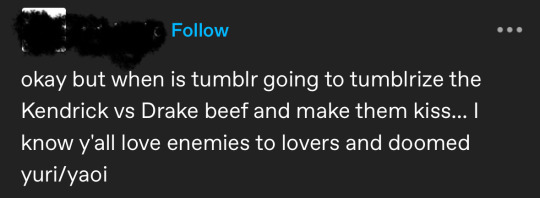
y’all remember we’re talking ab allegations of pedophilia and human trafficking and domestic violence right. real-life abuse. this isn’t fucking hannibal or Genshin or some shit even as a joke these posts are fucking weird
#sorry i turned rbs off this post is radioactive#og tags ->#am I being sensitive idk#but kdot’s been talking ab a very well-documented history of drake w predators and being a predator#also allegations of him abusing his partner#why make posts like this#x#kendrick lamar
9K notes
·
View notes
Text
friend wanted to see my tumblr, and when i told him i can’t show it to him bc it’s basically my personal diary he went “oh so I can’t see it but a bunch of strangers on tumblr can??” he literally does not get me. no one will get me like the people in my phone get me
#It’s just so different#even though it’s public it still feels secret and safe. i feel comfy sharing a lot more on here than I do in my actual day to day life lol#in my head I’m also just speaking to myself 90% of the time which helps#if a friend off tumblr saw my thoughts I’d feel so weird ab it#esp bc they might get the vagueposting about certain situations and tell mutual friends#no thank u. this is for me. I’m not about to start censoring my thoughts bc someone I know knows my tumblr#u guys literally saw me have LIVE BREAKDOWNS#meanwhile I’ll have the worst fucking day in history and tell no one about it. I’m already cripplingly private but way more so in real life#this is basically a low stress journaling outlet for me. it’s so important for me to maintain the separation#like this is actually my diary & has been so handy for letting out emotions / articulating thoughts / staying on track !!#& I’ve met so many kind people on here who actually get me. which is so hard to find irl bc I’m surrounded by pre-med gunners/overachievers#who are by standard not very good w emotion & can be competitive/judgmental. or at least it’s hard for me to be vulnerable in front of them#and I’m part of that crowd so I reserve my emotions only to a handful of very close friends#it’s nice to hop on here and express negative emotions!! or positive emotions!! just whatever I want and it’s low stress and people get me#I don’t have to worry about judgment or competitiveness etc etc#like everyone on here is so kind & nice & understanding. & just a breath of fresh air from the types I run w. it’s just nice to have this#so idk that’s why I think I’ll always be strict about keeping the worlds separate. it just works#p
8K notes
·
View notes
Text



Fun fact about me, my great-grandparents owned a motel in Kentucky in the 1950’s. These photos feel haunting, yet beautiful.
#I wish I could have seen it before it was demolished#Im so excited I tried so hard to find photos and my aunt found some!#This is such an aesthetic honestly#Also my house that my grandfather built used to be a gas station#I’m peak Americana#motel#americana#vintage americana#small town aesthetic#small town gothic#southern gothic#spamming tags sorry ab dat#abandoned#rural decay#appalachia#appalachain gothic#kentucky#american teenager#History
581 notes
·
View notes
Text
I really love Jaster Mereel, the most “fine then I’ll do it myself” guy of all time. Like, after he killed his corrupt superior UHC style and got exiled for it he could’ve been on that vigilante shit. And he did come back ready for a fight- but not with a battalion, or another assassination. With a fucking entire new system of living and governing contained in a codex he wrote himself, based on ancient laws he wanted to resurrect. By all accounts he wasn’t even in academia or government before that moment, he was a cop. And the best part is he fucking managed to create a majorly consequential schism in Mandalorian society purely on the strength of having actually really good ideas in that big-ass academic magnum opus he spite-wrote. That’s some Protestant reformation shit!!!! I wonder if someone said to him during his sentencing like “you can’t just make up your own laws because you disagree with the ones we have” and he said oh word?? Insane, I love him.
#he could have stopped at some bullet points too or a manifesto would’ve worked#but bro wrote the whole book#he had THINGS TO SAY and he wasn’t going to stop at some measly hundred pages#NOBODY was doing it like him.#he said fuck you i’ll show you a government. and he fucking did#like his balls were huge but simultaneously i wonder if he even anticipated the impact it would have#martin luther nailed up those 99 theses hoping to spark debate in local academia not start a schism#mereel had to know the death watch was gonna try to kill his ass for publishing that but he did it anyway#and i wonder if it just completely took off from under him#and hey as a student of history i have to think ab what the actual societal circumstances were#that that movement was able to happen.#he must’ve been tapping into some really widespread discontent you know#jaster mereel#true mandalorians#haat mando’ade#mandalorians#mandalorian history#supercommando codex#mandalorian civil war#mandalorian culture#mine#my meta#sw
234 notes
·
View notes
Text
amanda overton is the wlw writers' GOAT nobody talk to me

(link for the article)

she said let's give LESBIANS everything the straights have already had time and time again

i knew the romeo & juliet teas were real

she had all the right inspirations. tomb raider, mass effect, tlou. gosh i love her.

THIS IS WHY CHRISTIAN AND ALEX ARE ALSO THE GOATSSSSSSSS wow i need more feminist men in my life bro.


yuri cocaine YURI COCAINEEEEEEEEE

YURI COCAINEEEEEEEEEEEEEEEEEEEEEEEEEEE


amanda overton, every single oldest sister lesbian in the entire WORLD owes you their very lives.

#amanda i don't think the people comprehend how influential you are#this is wlw history and all because of YOU#in 10 in 20 years people will still be talking ab how pivotal and important and groundbreaking it was to have THIS lesbian love story exist#and play out as was written by a lesbian; as was meant for a lesbian audience#this is a korrasami-level milestone/moment/hingepoint/historical event#caitvi is on the world's WLW timeline DON'T EVEN PLAY WITH ME!!!!!#and it's all because of one woman#THAT'S WHAT I'M TALKING ABOUT!!!!!! 🗣🗣🗣#THAT'S WHY SHE'S THE MVP!!!!! 🗣🗣🗣#THAT'S WHY SHE'S THE GOAT. THE GOAT!!!!!! 🗣🗣🗣🗣🗣#she literally made gay history and it WILL be talked about FOR GAY GENERATIONS#i know i joke about yuri cocaine but she was actually on yuri genius like she sipped the dew of the universe for this AND DELIVERED#amanda overton#caitvi#piltover's finest#arcane#arcane season 2#arcane spoilers
229 notes
·
View notes
Text
Would you let me suck you on the first date?

#tra reciepts#trans history#trans hrt#trans sissy#trans hc#transhumance#transharmful#trans harry potter#trans hunter#trans happiness#trans horror#trans main character#transgender#transfem#trans ab/dl#trans pride#trans babe#trans beauty#trans community#trans cult#trans character#trans logic#trans love#trans lesbian#transfashion#trans woman#trans women are beautiful#trans male#trans memes#trans mtf
860 notes
·
View notes
Text
Honey you'd want to go hard or slowly? 🍆🍑
#mtf trans#transgender#trans acceptance#trans and proud#trans angel#trans ab/dl#trans activism#trans advice#trans ana#trans ally#trans people#transsexual#trans are beautiful#trans are women#trans babe#trans artist#trans beauty#trans bulge#trans artwork#trans body positivity#trans character#trans captions#trans bhm#trans community#trans content#trans cock#trans awareness#trans day of remembrance#trans history#trans pride
326 notes
·
View notes
Text

does anybody need some soft jarthur in these trying times
#i know I do goddamn#anyways. cute little thing I did in art history class :)) the pose is based off an image I found on Pinterest but idk what it’s from#jarthur#private eyes#john doe#arthur lester#malevolent#malevolent podcast#art#my art#my first time doing a human John…. idk how to feel ab it#but I do think that people rlly need to be making him more dilfy#and NOT just bc I’m biased towards dilfs ok#he’s got that deep baritone bro you can’t be twinkifying him
184 notes
·
View notes
Text
My version of clone high napoleon😁



He’d be soooo extra
+ some lore ideas idk
#napoleon#my art#napoleon bonaparte#clone high fan clone#still#does it count?#clone high#clone high topher#clone high gandhi#clone high joan#clone high jfk#clone high abe#drawing#fan art#history#idk
307 notes
·
View notes
Text
When people make hc posts about the punch out characters but leave out king hippo

#not ab anyone in particular just smth ive noticed#like listen..... ik he has the least characterization out of all the punchy men#but that just means u get to have sm fun w/ his personality !! the history !! his QUIRKS !!!!#hes a sassy man !!! he underestimates little mac !!! hes emotional after he loses !!!! theres sm potential there alone !!!!#the king hippo stan posts ab king hippo fork found in the kitchen#punch out#king hippo#monkey brain typing
84 notes
·
View notes
Text
saying “dean and sam are equally obsessive/abusive” when it’s canon that sam would’ve died locked up in the panic room because of dean’s decision is crazy (also don’t forget the fact that locking sam up was also about punishing him). it’s so obvious that some people are desperately trying to compare incomparable situations because they think sam should be the “more fucked up one” despite all the evidence (dean’s “if tables were turned…i’d let you rot in here. hell, i have let you rot in here” vs sam’s “yeah, well…i guess i’m not that smart”) that it’s the other way around when it comes to their relationship
#the so called samgirls who push the ab*sive controlling sam agenda make me sick#just say you’re actually a deangirl lmao#real samgirls know the fandom history and how sam’s character is treated by 99% of the fandom#also once again you’re comparing incomparable situations#because all of sam’s violence towards dean was only present when he was possessed or soulless#(sam was literally a victim here because he had no agency when possessed or soulless)#while dean’s ab*sive actions towards sam were coming from real unpossesed dean!#wincest#samdean#sam winchester#dean winchester#spn
75 notes
·
View notes
Text

Sharks or The Derelict – Winslow Homer // Irresistible – Fall Out Boy
#sharks#shark#winslow homer#irresistible#irresistible song#irresistible fall out boy#american beauty american psycho#american beauty / american psycho#american beauty/american psycho#ab/ap#fall out boy#fob#fob lyrics#fall out boy edit#fall out boy lyrics#art#art history#lyrics#lyric art
239 notes
·
View notes
Text

#Five Fascinating Facts About Abraham Lincoln#history#facts#trivia#U.S. history#president#U.S. presidents#Abe Lincoln#werewolf#werewolves#Moon#squirrels#talking dog#unreality#cotton candy
183 notes
·
View notes
Text
Shikigami and onmyōdō through history: truth, fiction and everything in between
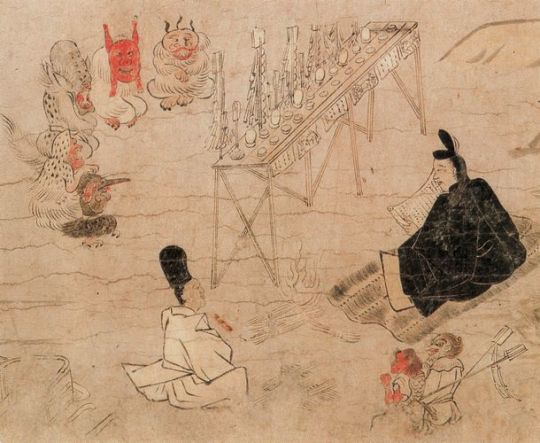
Abe no Seimei exorcising disease spirits (疫病神, yakubyōgami), as depicted in the Fudō Riyaku Engi Emaki. Two creatures who might be shikigami are visible in the bottom right corner (wikimedia commons; identification following Bernard Faure’s Rage and Ravage, pp. 57-58)
In popular culture, shikigami are basically synonymous with onmyōdō. Was this always the case, though? And what is a shikigami, anyway? These questions are surprisingly difficult to answer. I’ve been meaning to attempt to do so for a longer while, but other projects kept getting in the way. Under the cut, you will finally be able to learn all about this matter.
This isn’t just a shikigami article, though. Since historical context is a must, I also provide a brief history of onmyōdō and some of its luminaries. You will also learn if there were female onmyōji, when stars and time periods turn into deities, what onmyōdō has to do with a tale in which Zhong Kui became a king of a certain city in India - and more!
The early days of onmyōdō In order to at least attempt to explain what the term shikigami might have originally entailed, I first need to briefly summarize the history of onmyōdō (陰陽道). This term can be translated as “way of yin and yang”, and at the core it was a Japanese adaptation of the concepts of, well, yin and yang, as well as the five elements. They reached Japan through Daoist and Buddhist sources. Daoism itself never really became a distinct religion in Japan, but onmyōdō is arguably among the most widespread adaptations of its principles in Japanese context.
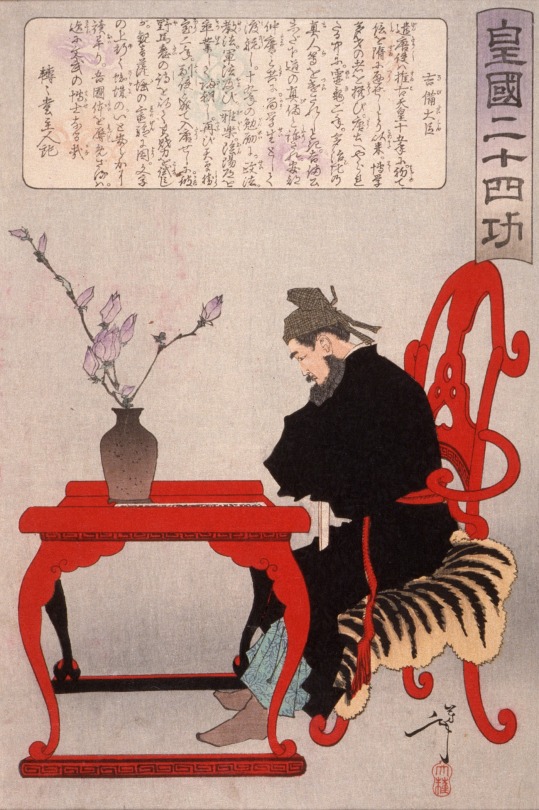
Kibi no Makibi, as depicted by Yoshitoshi Tsukioka (wikimedia commons)
It’s not possible to speak of a singular founder of onmyōdō comparable to the patriarchs of Buddhist schools. Bernard Faure notes that in legends the role is sometimes assigned to Kibi no Makibi, an eighth century official who spent around 20 years in China. While he did bring many astronomical treatises with him when he returned, this is ultimately just a legend which developed long after he passed away.
In reality onmyōdō developed gradually starting with the sixth century, when Chinese methods of divination and treatises dealing with these topics first reached Japan. Early on Buddhist monks from the Korean kingdom of Baekje were the main sources of this knowledge. We know for example that the Soga clan employed such a specialist, a certain Gwalleuk (観勒; alternatively known under the Japanese reading of his name, Kanroku).
Obviously, divination was viewed as a very serious affair, so the imperial court aimed to regulate the continental techniques in some way. This was accomplished by emperor Tenmu with the formation of the onmyōryō (陰陽寮), “bureau of yin and yang” as a part of the ritsuryō system of governance. Much like in China, the need to control divination was driven by the fears that otherwise it would be used to legitimize courtly intrigues against the emperor, rebellions and other disturbances. Officials taught and employed by onmyōryō were referred to as onmyōji (陰陽師). This term can be literally translated as “yin-yang master”. In the Nara period, they were understood essentially as a class of public servants. Their position didn’t substantially differ from that of other specialists from the onmyōryō: calendar makers, officials responsible for proper measurement of time and astrologers. The topics they dealt with evidently weren’t well known among commoners, and they were simply typical members of the literate administrative elite of their times.
Onmyōdō in the Heian period: magic, charisma and nobility
The role of onmyōji changed in the Heian period. They retained the position of official bureaucratic diviners in employ of the court, but they also acquired new duties. The distinction between them and other onmyōryō officials became blurred. Additionally their activity extended to what was collectively referred to as jujutsu (呪術), something like “magic” though this does not fully reflect the nuances of this term. They presided over rainmaking rituals, purification ceremonies, so-called “earth quelling”, and establishing complex networks of temporal and directional taboos.

A Muromachi period depiction of Abe no Seimei (wikimedia commons)
The most famous historical onmyōji like Kamo no Yasunori and his student Abe no Seimei were active at a time when this version of onmyōdō was a fully formed - though obviously still evolving - set of practices and beliefs. In a way they represented a new approach, though - one in which personal charisma seemed to matter just as much, if not more, than official position. This change was recognized as a breakthrough by at least some of their contemporaries. For example, according to the diary of Minamoto no Tsuneyori, the Sakeiki (左經記), “in Japan, the foundations of onmyōdō were laid by Yasunori”.
The changes in part reflected the fact that onmyōji started to be privately contracted for various reasons by aristocrats, in addition to serving the state. Shin’ichi Shigeta notes that it essentially turned them from civil servants into tradespeople. However, he stresses they cannot be considered clergymen: their position was more comparable to that of physicians, and there is no indication they viewed their activities as a distinct religion. Indeed, we know of multiple Heian onmyōji, like Koremune no Fumitaka or Kamo no Ieyoshi, who by their own admission were devout Buddhists who just happened to work as professional diviners.
Shin’ichi Shigeta notes is evidence that in addition to the official, state-sanctioned onmyōji, “unlicensed” onmyōji who acted and dressed like Buddhist clergy, hōshi onmyōji (法師陰陽師) existed. The best known example is Ashiya Dōman, a mainstay of Seimei legends, but others are mentioned in diaries, including the famous Pillow Book. It seems nobles particularly commonly employed them to curse rivals. This was a sphere official onmyōji abstained from due to legal regulations. Curses were effectively considered crimes, and government officials only performed apotropaic rituals meant to protect from them. The Heian period version of onmyōdō captivated the imagination of writers and artists, and its slightly exaggerated version present in classic literature like Konjaku Monogatari is essentially what modern portrayals in fiction tend to go back to.
Medieval onmyōdō: from abstract concepts to deities
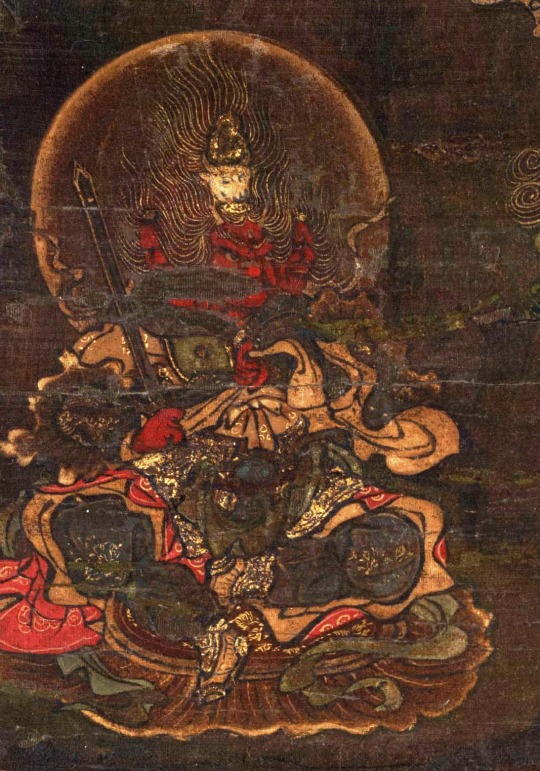
Gozu Tennō (wikimedia commons)
Further important developments occurred between the twelfth and fourteenth centuries. This period was the beginning of the Japanese “middle ages” which lasted all the way up to the establishment of the Tokugawa shogunate. The focus in onmyōdō in part shifted towards new, or at least reinvented, deities, such as calendarical spirits like Daishōgun (大将軍) and Ten’ichijin (天一神), personifications of astral bodies and concepts already crucial in earlier ceremonies. There was also an increased interest in Chinese cosmological figures like Pangu, reimagined in Japan as “king Banko”. However, the most famous example is arguably Gozu Tennō, who you might remember from my Susanoo article.
The changes in medieval onmyōdō can be described as a process of convergence with esoteric Buddhism. The points of connection were rituals focused on astral and underworld deities, such as Taizan Fukun or Shimei (Chinese Siming). Parallels can be drawn between this phenomenon and the intersection between esoteric Buddhism and some Daoist schools in Tang China. Early signs of the development of a direct connection between onmyōdō and Buddhism can already be found in sources from the Heian period, for example Kamo no Yasunori remarked that he and other onmyōji depend on the same sources to gain proper understanding of ceremonies focused on the Big Dipper as Shingon monks do.
Much of the information pertaining to the medieval form of onmyōdō is preserved in Hoki Naiden (ほき内伝; “Inner Tradition of the Square and the Round Offering Vessels”), a text which is part divination manual and part a collection of myths. According to tradition it was compiled by Abe no Seimei, though researchers generally date it to the fourteenth century. For what it’s worth, it does seem likely its author was a descendant of Seimei, though. Outside of specialized scholarship Hoki Naiden is fairly obscure today, but it’s worth noting that it was a major part of the popular perception of onmyōdō in the Edo period. A novel whose influence is still visible in the modern image of Seimei, Abe no Seimei Monogatari (安部晴明物語), essentially revolves around it, for instance.
Onmyōdō in the Edo period: occupational licensing
Novels aside, the first post-medieval major turning point for the history of onmyōdō was the recognition of the Tsuchimikado family as its official overseers in 1683. They were by no means new to the scene - onmyōji from this family already served the Ashikaga shoguns over 250 years earlier. On top of that, they were descendants of the earlier Abe family, the onmyōji par excellence. The change was not quite the Tsuchimikado’s rise, but rather the fact the government entrusted them with essentially regulating occupational licensing for all onmyōji, even those who in earlier periods existed outside of official administration.
As a result of the new policies, various freelance practitioners could, at least in theory, obtain a permit to perform the duties of an onmyōji. However, as the influence of the Tsuchimikado expanded, they also sought to oblige various specialists who would not be considered onmyōji otherwise to purchase licenses from them. Their aim was to essentially bring all forms of divination under their control. This extended to clergy like Buddhist monks, shugenja and shrine priests on one hand, and to various performers like members of kagura troupes on the other.
Makoto Hayashi points out that while throughout history onmyōji has conventionally been considered a male occupation, it was possible for women to obtain licenses from the Tsuchimikado. Furthermore, there was no distinct term for female onmyōji, in contrast with how female counterparts of Buddhist monks, shrine priests and shugenja were referred to with different terms and had distinct roles defined by their gender. As far as I know there’s no earlier evidence for female onmyōji, though, so it’s safe to say their emergence had a lot to do with the specifics of the new system. It seems the poems of the daughter of Kamo no Yasunori (her own name is unknown) indicate she was familiar with yin-yang theory or at least more broadly with Chinese philosophy, but that’s a topic for a separate article (stay tuned), and it's not quite the same, obviously.
The Tsuchimikado didn’t aim to create a specific ideology or systems of beliefs. Therefore, individual onmyōji - or, to be more accurate, individual people with onmyōji licenses - in theory could pursue new ideas. This in some cases lead to controversies: for instance, some of the people involved in the (in)famous 1827 Osaka trial of alleged Christians (whether this label really is applicable is a matter of heated debate) were officially licensed onmyōji. Some of them did indeed possess translated books written by Portuguese missionaries, which obviously reflected Catholic outlook. However, Bernard Faure suggests that some of the Edo period onmyōji might have pursued Portuguese sources not strictly because of an interest in Catholicism but simply to obtain another source of astronomical knowledge.
The legacy of onmyōdō
In the Meiji period, onmyōdō was banned alongside shugendō. While the latter tradition experienced a revival in the second half of the twentieth century, the former for the most part didn’t. However, that doesn’t mean the history of onmyōdō ends once and for all in the second half of the nineteenth century.
Even today in some parts of Japan there are local religious traditions which, while not identical with historical onmyōdō, retain a considerable degree of influence from it. An example often cited in scholarship is Izanagi-ryū (いざなぎ流) from the rural Monobe area in the Kōchi Prefecture. Mitsuki Ueno stresses that the occasional references to Izanagi-ryū as “modern onmyōdō” in literature from the 1990s and early 2000s are inaccurate, though. He points out they downplay the unique character of this tradition, and that it shows a variety of influences. Similar arguments have also been made regarding local traditions from the Chūgoku region.
Until relatively recently, in scholarship onmyōdō was basically ignored as superstition unworthy of serious inquiries. This changed in the final decades of the twentieth century, with growing focus on the Japanese middle ages among researchers. The first monographs on onmyōdō were published in the 1980s. While it’s not equally popular as a subject of research as esoteric Buddhism and shugendō, formerly neglected for similar reasons, it has nonetheless managed to become a mainstay of inquiries pertaining to the history of religion in Japan.
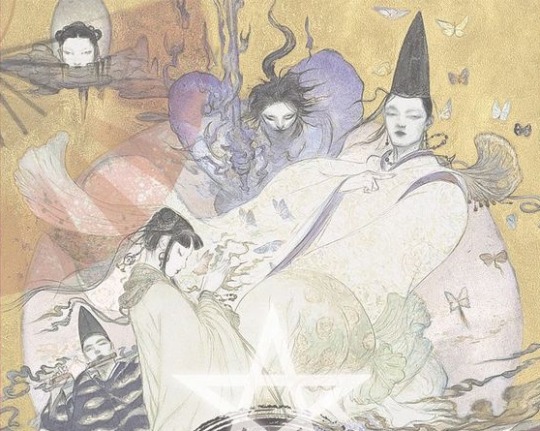
Yoshitaka Amano's illustration of Baku Yumemakura's fictionalized portrayal of Abe no Seimei (right) and other characters from his novels (reproduced here for educational purposes only)
Of course, it’s also impossible to talk about onmyōdō without mentioning the modern “onmyōdō boom”. Starting with the 1980s, onmyōdō once again became a relatively popular topic among writers. Novel series such as Baku Yumemakura’s Onmyōji, Hiroshi Aramata’s Teito Monogatari or Natsuhiko Kyōgoku’s Kyōgōkudō and their adaptations in other media once again popularized it among general audiences. Of course, since these are fantasy or mystery novels, their historical accuracy tends to vary (Yumemakura in particular is reasonably faithful to historical literature, though). Still, they have a lasting impact which would be impossible to accomplish with scholarship alone.
Shikigami: historical truth, historical fiction, or both?
You might have noticed that despite promising a history of shikigami, I haven’t used this term even once through the entire crash course in history of onmyōdō. This was a conscious choice. Shikigami do not appear in any onmyōdō texts, even though they are a mainstay of texts about onmyōdō, and especially of modern literature involving onmyōji.
It would be unfair to say shikigami and their prominence are merely a modern misconception, though. Virtually all of the famous legends about onmyōji feature shikigami, starting with the earliest examples from the eleventh century. Based on Konjaku Monogatari, there evidently was a fascination with shikigami at the time of its compilation. Fujiwara no Akihira in the Shinsarugakuki treats the control of shikigami as an essential skill of an onmyōji, alongside the abilities to “freely summon the twelve guardian deities, call thirty-six types of wild birds (...), create spells and talismans, open and close the eyes of kijin (鬼神; “demon gods”), and manipulate human souls”.
It is generally agreed that such accounts, even though they belong to the realm of literary fiction, can shed light on the nature and importance of shikigami. They ultimately reflect their historical context to some degree. Furthermore, it is not impossible that popular understanding of shikigami based on literary texts influenced genuine onmyōdō tradition. It’s worth pointing out that today legends about Abe no Seimei involving them are disseminated by two contemporary shrines dedicated to him, the Seimei Shrine (晴明神社) in Kyoto and the Abe no Seimei Shrine (安倍晴明神社) in Osaka. Interconnected networks of exchange between literature and religious practice are hardly a unique or modern phenomenon.
However, even with possible evidence from historical literature taken into account, it is not easy to define shikigami. The word itself can be written in three different ways: 式神 (or just 式), 識神 and 職神, with the first being the default option. The descriptions are even more varied, which understandably lead to the rise of numerous interpretations in modern scholarship. Carolyn Pang in her recent treatments of shikigami, which you can find in the bibliography, has recently divided them into five categories. I will follow her classification below.
Shikigami take 1: rikujin-shikisen
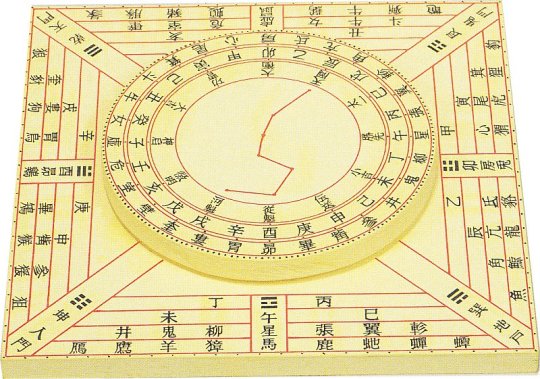
An example of shikiban, the divination board used in rikujin-shikisen (Museum of Kyoto, via onmarkproductions.com; reproduced here for educational purposes only)
A common view is that shikigami originate as a symbolic representation of the power of shikisen (式占) or more specifically rikujin-shikisen (六壬式占), the most common form of divination in onmyōdō. It developed from Chinese divination methods in the Nara period, and remained in the vogue all the way up to the sixteenth century, when it was replaced by ekisen (易占), a method derived from the Chinese Book of Changes.
Shikisen required a special divination board known as shikiban (式盤), which consists of a square base, the “earth panel” (地盤, jiban), and a rotating circle placed on top of it, the “heaven panel” (天盤, tenban). The former was marked with twelve points representing the signs of the zodiac and the latter with representations of the “twelve guardians of the months” (十二月将, jūni-gatsushō; their identity is not well defined). The heaven panel had to be rotated, and the diviner had to interpret what the resulting combination of symbols represents. Most commonly, it was treated as an indication whether an unusual phenomenon (怪/恠, ke) had positive or negative implications. It’s worth pointing out that in the middle ages the shikiban also came to be used in some esoteric Buddhist rituals, chiefly these focused on Dakiniten, Shōten and Nyoirin Kannon. However, they were only performed between the late Heian and Muromachi periods, and relatively little is known about them. In most cases the divination board was most likely modified to reference the appropriate esoteric deities.
Shikigami take 2: cognitive abilities
While the view that shikigami represented shikisen is strengthened by the fact both terms share the kanji 式, a variant writing, 識神, lead to the development of another proposal. Since the basic meaning of 識 is “consciousness”, it is sometimes argued that shikigami were originally an “anthropomorphic realization of the active psychological or mental state”, as Caroline Pang put it - essentially, a representation of the will of an onmyōji. Most of the potential evidence in this case comes from Buddhist texts, such as Bosatsushotaikyō (菩薩処胎経).
However, Bernard Faure assumes that the writing 識神 was a secondary reinterpretation, basically a wordplay based on homonymy. He points out the Buddhist sources treat this writing of shikigami as a synonym of kushōjin (倶生神). This term can be literally translated as “deities born at the same time”. Most commonly it designates a pair of minor deities who, as their name indicates, come into existence when a person is born, and then records their deeds through their entire life. Once the time for Enma’s judgment after death comes, they present him with their compiled records. It has been argued that they essentially function like a personification of conscience.
Shikigami take 3: energy
A further speculative interpretation of shikigami in scholarship is that this term was understood as a type of energy present in objects or living beings which onmyōji were believed to be capable of drawing out and harnessing to their ends. This could be an adaptation of the Daoist notion of qi (氣). If this definition is correct, pieces of paper or wooden instruments used in purification ceremonies might be examples of objects utilized to channel shikigami.
The interpretation of shikigami as a form of energy is possibly reflected in Konjaku Monogatari in the tale The Tutelage of Abe no Seimei under Tadayuki. It revolves around Abe no Seimei’s visit to the house of the Buddhist monk Kuwanten from Hirosawa. Another of his guests asks Seimei if he is capable of killing a person with his powers, and if he possesses shikigami. He affirms that this is possible, but makes it clear that it is not an easy task. Since the guests keep urging him to demonstrate nonetheless, he promptly demonstrates it using a blade of grass. Once it falls on a frog, the animal is instantly crushed to death. From the same tale we learn that Seimei’s control over shikigami also let him remotely close the doors and shutters in his house while nobody was inside.
Shikigami take 4: curse As I already mentioned, arts which can be broadly described as magic - like the already mentioned jujutsu or juhō (呪法, “magic rituals”) - were regarded as a core part of onmyōji’s repertoire from the Heian period onward. On top of that, the unlicensed onmyōji were almost exclusively associated with curses. Therefore, it probably won’t surprise you to learn that yet another theory suggests shikigami is simply a term for spells, curses or both. A possible example can be found in Konjaku Monogatari, in the tale Seimei sealing the young Archivist Minor Captains curse - the eponymous curse, which Seimei overcomes with protective rituals, is described as a shikigami.

Kunisuda Utagawa's illustration of an actor portraying Dōman in a kabuki play (wikimedia commons)
Similarities between certain descriptions of shikigami and practices such as fuko (巫蠱) and goraihō (五雷法) have been pointed out. Both of these originate in China. Fuko is the use of poisonous, venomous or otherwise negatively perceived animals to create curses, typically by putting them in jars, while goraihō is the Japanese version of Daoist spells meant to control supernatural beings, typically ghosts or foxes. It’s worth noting that a legend according to which Dōman cursed Fujiwara no Michinaga on behalf of lord Horikawa (Fujiwara no Akimitsu) involves him placing the curse - which is itself not described in detail - inside a jar.
Mitsuki Ueno notes that in the Kōchi Prefecture the phrase shiki wo utsu, “to strike with a shiki”, is still used to refer to cursing someone. However, shiki does not necessarily refer to shikigami in this context, but rather to a related but distinct concept - more on that later.
Shikigami take 5: supernatural being
While all four definitions I went through have their proponents, yet another option is by far the most common - the notion of shikigami being supernatural beings controlled by an onmyōji. This is essentially the standard understanding of the term today among general audiences. Sometimes attempts are made to identify it with a specific category of supernatural beings, like spirits (精霊, seirei), kijin or lesser deities (下級神, kakyū shin). However, none of these gained universal support. Generally speaking, there is no strong indication that shikigami were necessarily imagined as individualized beings with distinct traits.
The notion of shikigami being supernatural beings is not just a modern interpretation, though, for the sake of clarity. An early example where the term is unambiguously used this way is a tale from Ōkagami in which Seimei sends a nondescript shikigami to gather information. The entity, who is not described in detail, possesses supernatural skills, but simultaneously still needs to open doors and physically travel.
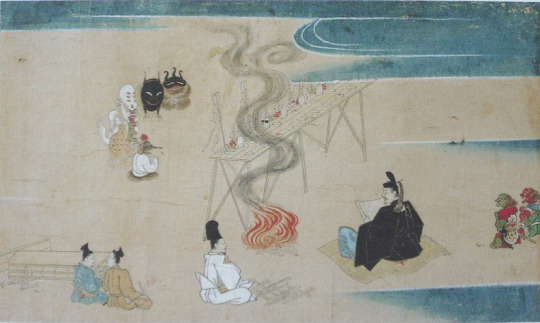
An illustration from Nakifudō Engi Emaki (wikimedia commons)
In Genpei Jōsuiki there is a reference to Seimei’s shikigami having a terrifying appearance which unnerved his wife so much he had to order the entities to hide under a bride instead of residing in his house. Carolyn Pang suggests that this reflects the demon-like depictions from works such as Abe no Seimei-kō Gazō (安倍晴明公画像; you can see it in the Heian section), Fudōriyaku Engi Emaki and Nakifudō Engi Emaki.
Shikigami and related concepts
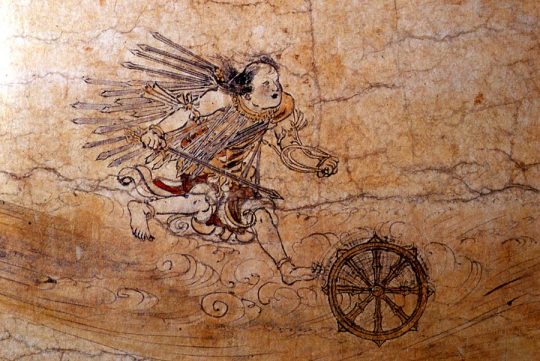
A gohō dōji, as depicted in the Shigisan Engi Emaki (wikimedia commons)
The understanding of shikigami as a “spirit servant” of sorts can be compared with the Buddhist concept of minor protective deities, gohō dōji (護法童子; literally “dharma-protecting lads”). These in turn were just one example of the broad category of gohō (護法), which could be applied to virtually any deity with protective qualities, like the historical Buddha’s defender Vajrapāṇi or the Four Heavenly Kings. A notable difference between shikigami and gohō is the fact that the former generally required active summoning - through chanting spells and using mudras - while the latter manifested on their own in order to protect the pious. Granted, there are exceptions. There is a well attested legend according to which Abe no Seimei’s shikigami continued to protect his residence on own accord even after he passed away. Shikigami acting on their own are also mentioned in Zoku Kojidan (続古事談). It attributes the political downfall of Minamoto no Takaakira (源高明; 914–98) to his encounter with two shikigami who were left behind after the onmyōji who originally summoned them forgot about them.
A degree of overlap between various classes of supernatural helpers is evident in texts which refer to specific Buddhist figures as shikigami. I already brought up the case of the kushōjin earlier. Another good example is the Tendai monk Kōshū’s (光宗; 1276–1350) description of Oto Gohō (乙護法). He is “a shikigami that follows us like the shadow follows the body. Day or night, he never withdraws; he is the shikigami that protects us” (translation by Bernard Faure). This description is essentially a reversal of the relatively common title “demon who constantly follow beings” (常随魔, jōzuima). It was applied to figures such as Kōjin, Shōten or Matarajin, who were constantly waiting for a chance to obstruct rebirth in a pure land if not placated properly.

The Twelve Heavenly Generals (Tokyo National Museum, via wikimedia commons)
A well attested group of gohō, the Twelve Heavenly Generals (十二神将, jūni shinshō), and especially their leader Konpira (who you might remember from my previous article), could be labeled as shikigami. However, Fujiwara no Akihira’s description of onmyōji skills evidently presents them as two distinct classes of beings.
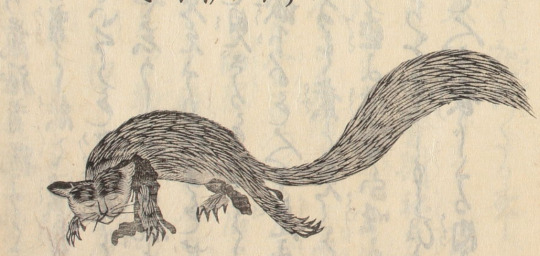
A kuda-gitsune, as depicted in Shōzan Chomon Kishū by Miyoshi Shōzan (Waseda University History Museum; reproduced here for educational purposes only)
Granted, Akihira also makes it clear that controlling shikigami and animals are two separate skills. Meanwhile, there is evidence that in some cases animal familiars, especially kuda-gitsune used by iizuna (a term referring to shugenja associated with the cult of, nomen omen, Iizuna Gongen, though more broadly also something along the lines of “sorcerer”), were perceived as shikigami.
Beliefs pertaining to gohō dōji and shikigami seemingly merged in Izanagi-ryū, which lead to the rise of the notion of shikiōji (式王子; ōji, literally “prince”, can be another term for gohō dōji). This term refers to supernatural beings summoned by a ritual specialist (祈祷師, kitōshi) using a special formula from doctrinal texts (法文, hōmon). They can fulfill various functions, though most commonly they are invoked to protect a person, to remove supernatural sources of diseases, to counter the influence of another shikiōji or in relation to curses.
Tenkeisei, the god of shikigami
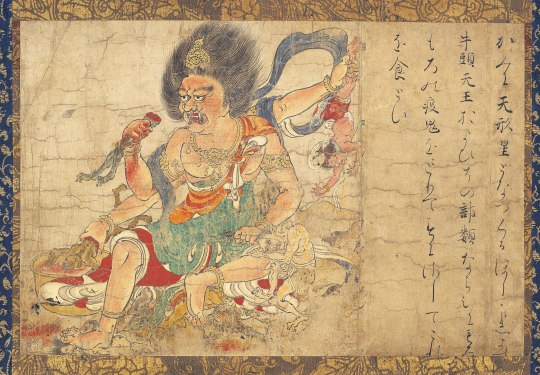
Tenkeisei (wikimedia commons)
The final matter which warrants some discussion is the unusual tradition regarding the origin of shikigami which revolves around a deity associated with this concept.
In the middle ages, a belief that there were exactly eighty four thousand shikigami developed. Their source was the god Tenkeisei (天刑星; also known as Tengyōshō). His name is the Japanese reading of Chinese Tianxingxing. It can be translated as “star of heavenly punishment”. This name fairly accurately explains his character. He was regarded as one of the so-called “baleful stars” (凶星, xiong xing) capable of controlling destiny. The “punishment” his name refers to is his treatment of disease demons (疫鬼, ekiki). However, he could punish humans too if not worshiped properly.
Today Tenkeisei is best known as one of the deities depicted in a series of paintings known as Extermination of Evil, dated to the end of the twelfth century. He has the appearance of a fairly standard multi-armed Buddhist deity. The anonymous painter added a darkly humorous touch by depicting him right as he dips one of the defeated demons in vinegar before eating him. Curiously, his adversaries are said to be Gozu Tennō and his retinue in the accompanying text. This, as you will quickly learn, is a rather unusual portrayal of the relationship between these two deities.
I’m actually not aware of any other depictions of Tenkeisei than the painting you can see above. Katja Triplett notes that onmyōdō rituals associated with him were likely surrounded by an aura of secrecy, and as a result most depictions of him were likely lost or destroyed. At the same time, it seems Tenkeisei enjoyed considerable popularity through the Kamakura period. This is not actually paradoxical when you take the historical context into account: as I outlined in my recent Amaterasu article, certain categories of knowledge were labeled as secret not to make their dissemination forbidden, but to imbue them with more meaning and value.
Numerous talismans inscribed with Tenkeisei’s name are known. Furthermore, manuals of rituals focused on him have been discovered. The best known of them, Tenkeisei-hō (天刑星法; “Tenkeisei rituals”), focuses on an abisha (阿尾捨, from Sanskrit āveśa), a ritual involving possession by the invoked deity. According to a legend was transmitted by Kibi no Makibi and Kamo no Yasunori. The historicity of this claim is doubtful, though: the legend has Kamo no Yasunori visit China, which he never did. Most likely mentioning him and Makibi was just a way to provide the text with additional legitimacy.
Other examples of similar Tenkeisei manuals include Tenkeisei Gyōhō (天刑星行法; “Methods of Tenkeisei Practice”) and Tenkeisei Gyōhō Shidai (天刑星行法次第; “Methods of Procedure for the Tenkeisei Practice”). Copies of these texts have been preserved in the Shingon temple Kōzan-ji.
The Hoki Naiden also mentions Tenkeisei. It equates him with Gozu Tennō, and explains both of these names refer to the same deity, Shōki (商貴), respectively in heaven and on earth. While Shōki is an adaptation of the famous Zhong Kui, it needs to be pointed out that here he is described not as a Tang period physician but as an ancient king of Rajgir in India. Furthermore, he is a yaksha, not a human. This fairly unique reinterpretation is also known from the historical treatise Genkō Shakusho. Post scriptum The goal of this article was never to define shikigami. In the light of modern scholarship, it’s basically impossible to provide a single definition in the first place. My aim was different: to illustrate that context is vital when it comes to understanding obscure historical terms. Through history, shikigami evidently meant slightly different things to different people, as reflected in literature. However, this meaning was nonetheless consistently rooted in the evolving perception of onmyōdō - and its internal changes. In other words, it reflected a world which was fundamentally alive. The popular image of Japanese culture and religion is often that of an artificial, unchanging landscape straight from the “age of the gods”, largely invented in the nineteenth century or later to further less than noble goals. The case of shikigami proves it doesn’t need to be, though. The malleable, ever-changing image of shikigami, which remained a subject of popular speculation for centuries before reemerging in a similar role in modern times, proves that the more complex reality isn’t necessarily any less interesting to new audiences.
Bibliography
Bernard Faure, A Religion in Search of a Founder?
Idem, Rage and Ravage (Gods of Medieval Japan vol. 3)
Makoto Hayashi, The Female Christian Yin-Yang Master
Jun’ichi Koike, Onmyōdō and Folkloric Culture: Three Perspectives for the Development of Research
Irene H. Lin, Child Guardian Spirits (Gohō Dōji) in the Medieval Japanese Imaginaire
Yoshifumi Nishioka, Aspects of Shikiban-Based Mikkyō Rituals
Herman Ooms, Yin-Yang's Changing Clientele, 600-800 (note there is n apparent mistake in one of the footnotes, I'm pretty sure the author wanted to write Mesopotamian astronomy originated 4000 years ago, not 4 millenia BCE as he did; the latter date makes little sense)
Carolyn Pang, Spirit Servant: Narratives of Shikigami and Onmyōdō Developments
Idem, Uncovering Shikigami. The Search for the Spirit Servant of Onmyōdō
Shin’ichi Shigeta, Onmyōdō and the Aristocratic Culture of Everyday Life in Heian Japan
Idem, A Portrait of Abe no Seimei
Katja Triplett, Putting a Face on the Pathogen and Its Nemesis. Images of Tenkeisei and Gozutennō, Epidemic-Related Demons and Gods in Medieval Japan
Mitsuki Umeno, The Origins of the Izanagi-ryū Ritual Techniques: On the Basis of the Izanagi saimon
Katsuaki Yamashita, The Characteristics of On'yōdō and Related Texts
184 notes
·
View notes